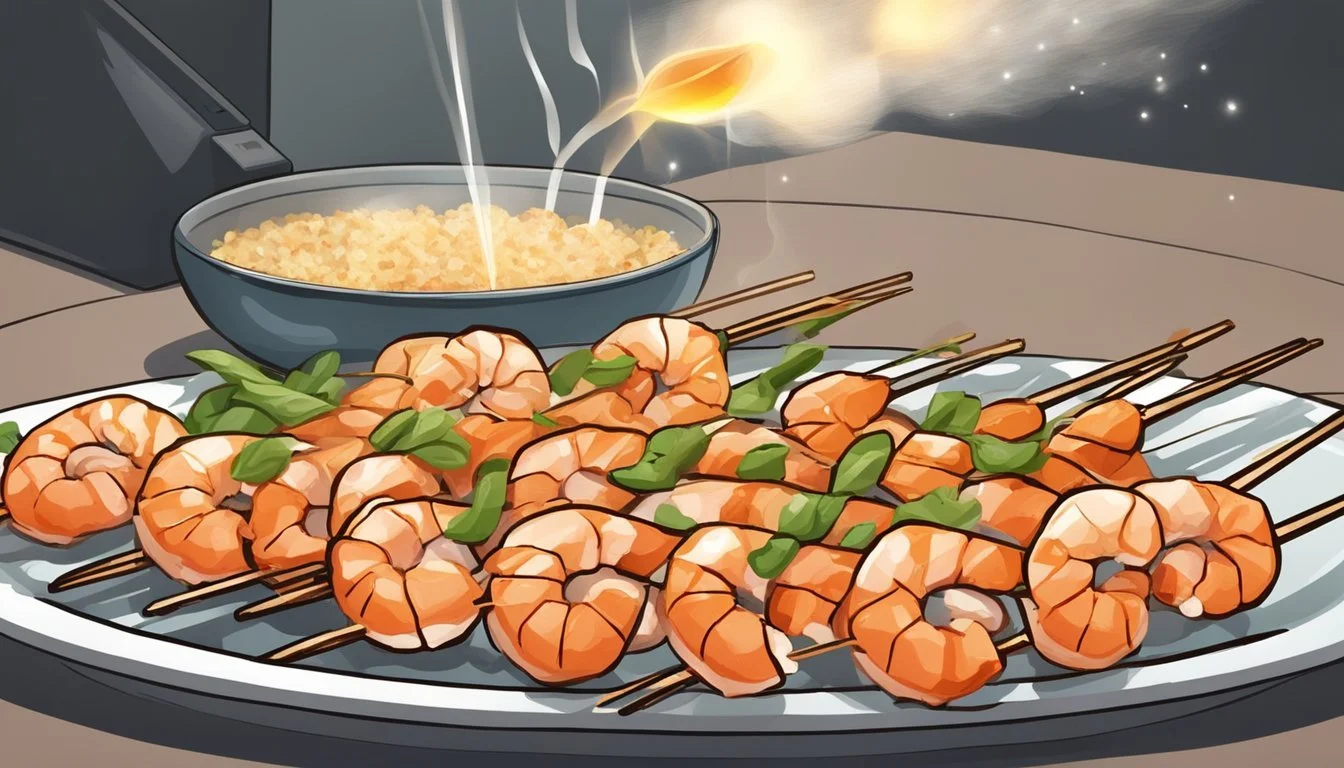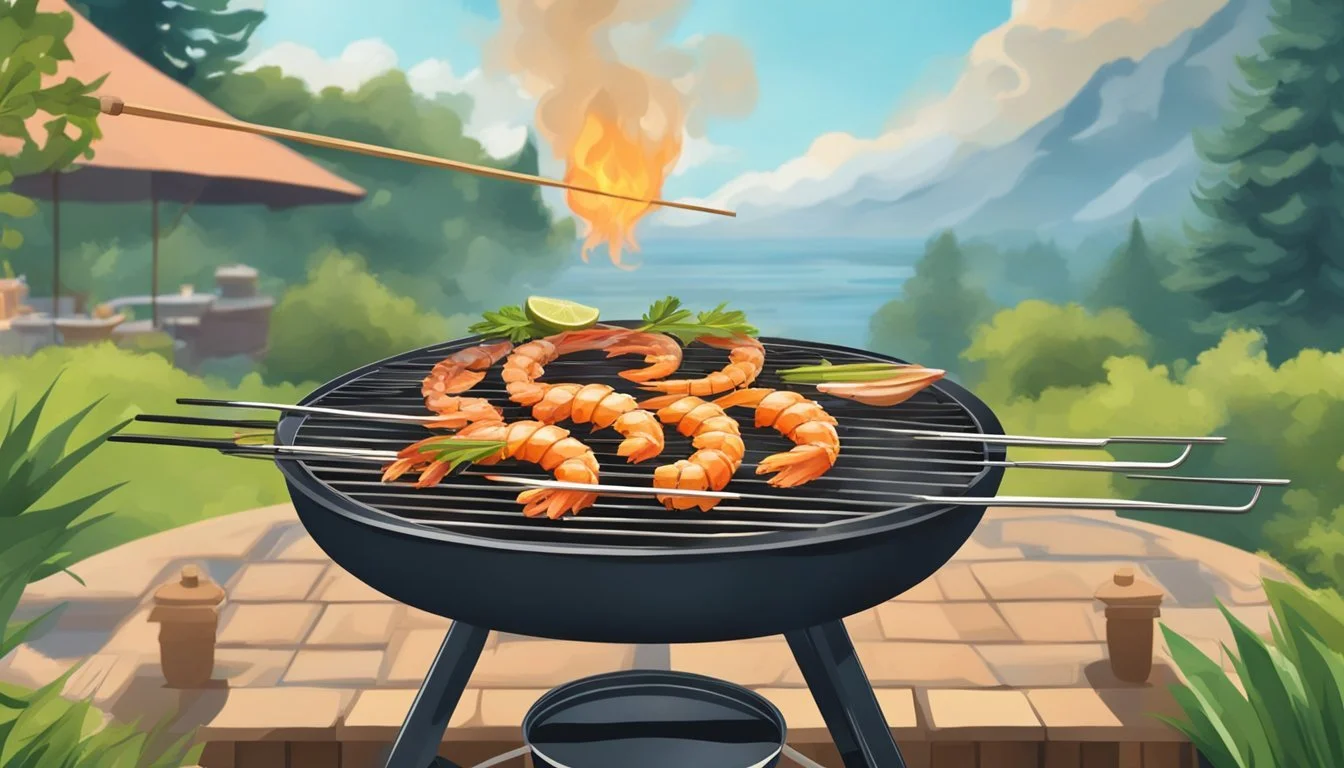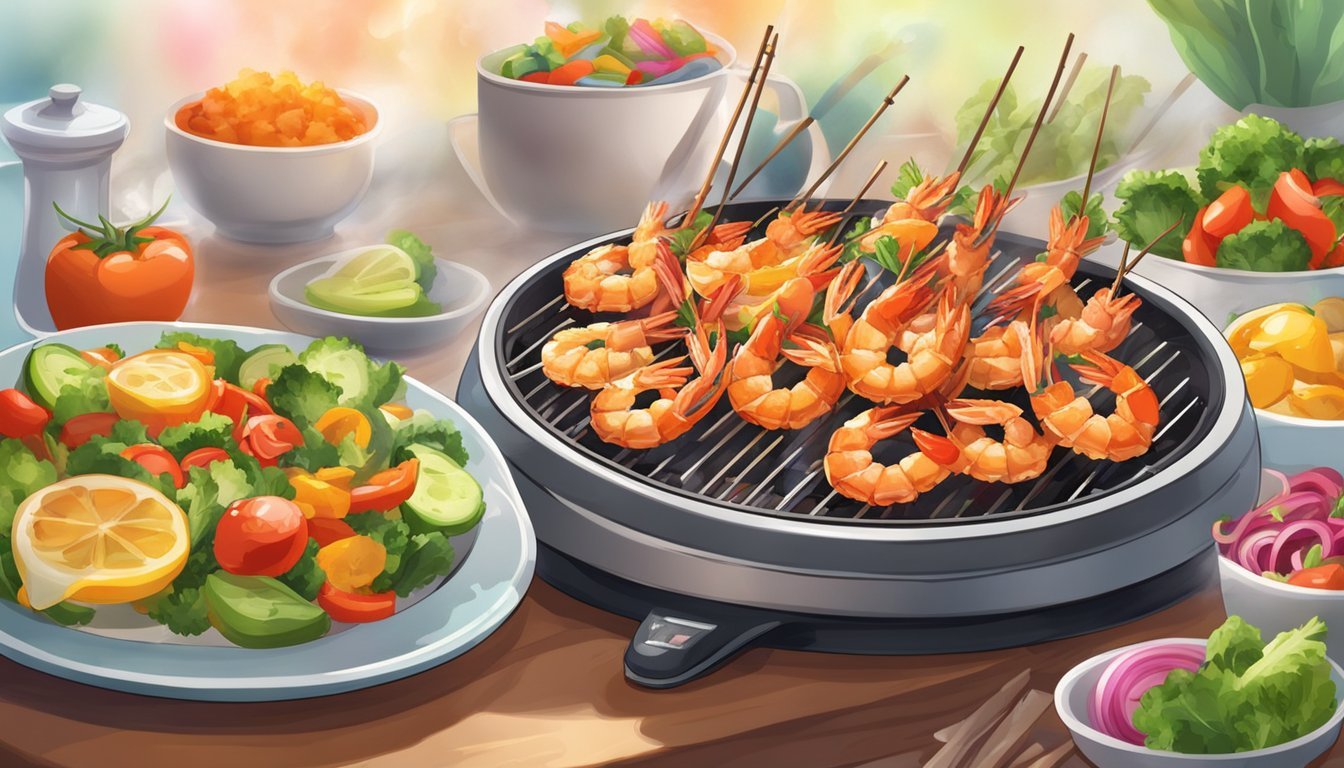How to Reheat Gluten-Free Grilled Shrimp Skewers
Best Methods and Tips
Grilled shrimp skewers are a delightful summer treat, particularly when they are both gluten-free and packed with flavor. To reheat gluten-free grilled shrimp skewers efficiently, preheat your oven to 350°F (175°C) and spread the shrimp in a single layer on a baking sheet. Cover lightly with aluminum foil or parchment paper to retain moisture and heat for 5-10 minutes. This method ensures that the shrimp remain juicy without becoming overcooked.
Grilling shrimp skewers is quick and easy, making them an excellent choice for a healthy summer meal. When preparing shrimp skewers, it's essential to soak wooden skewers for at least 20 minutes to prevent burning. Coat the shrimp evenly with olive oil and spices like smoked paprika, garlic powder, and onion powder for a delicious, gluten-free option.
Healthy and delicious, gluten-free grilled shrimp skewers are perfect for any summer gathering. After marinating the shrimp briefly, grill them for about 2-3 minutes per side until they turn opaque. This minimal cooking time preserves the shrimp's natural flavors and textures, making it a favorite dish for many. Enjoy these skewers straight from the grill or reheated using the oven method for a quick and satisfying meal.
Choosing the Right Shrimp and Skewers
Picking the appropriate shrimp and skewers is essential for a successful grilling experience. The key points include selecting the right size and type of shrimp and choosing between various skewer materials for optimal results.
Selecting Shrimp for Grilling
When selecting shrimp for grilling, large shrimp or jumbo shrimp are ideal. Their size ensures they remain juicy and flavorful during cooking. Opt for shrimp that are peeled and deveined to save time and effort. Raw shrimp is preferred over pre-cooked, as it absorbs marinades better and develops more flavor on the grill.
It's important to pay attention to the count per pound when buying shrimp. For grilling purposes, a count of 16-20 per pound provides a good balance between size and cooking efficiency. Always choose fresh shrimp when possible; if not, frozen shrimp is a good alternative. Ensure frozen shrimp is thawed properly before grilling.
Types of Skewers
Choosing the right skewer material can greatly impact the grilling process. Wooden skewers, including bamboo ones, are popular for their affordability and disposability. However, they must be soaked in water for at least 20-30 minutes before grilling to prevent burning.
Metal skewers are reusable and provide even cooking due to their heat conductivity. They are more durable and do not require soaking, making them convenient for frequent grillers.
Both types of skewers have their benefits. Wooden skewers are great for one-time use and variety, while metal skewers offer longevity and consistency. Consider your grilling frequency and preference when choosing the right skewer type.
Preparing Your Shrimp Skewers
To achieve perfect grilled shrimp skewers, focus on cleaning and marinating the shrimp, then follow the correct skewering technique to ensure even cooking.
Cleaning and Marinating
Begin by cleaning the shrimp thoroughly. Remove the shell, legs, and devein each shrimp. Rinse them under cold water and pat them dry using paper towels.
Marination is crucial for flavor enhancement. In a large mixing bowl, combine the cleaned shrimp with olive oil, garlic powder, paprika, black pepper, and salt. Optionally, add freshly squeezed lemon juice and lemon zest for a zesty kick. Mix until all the shrimp are well-coated. Let the shrimp marinate in the refrigerator for at least 20 minutes to absorb the flavors deeply.
Skewering Technique
For successful skewering, it is recommended to use wooden skewers that have been soaked in water for at least 20 minutes. This helps prevent them from burning on the grill.
Thread the shrimp onto the skewers, piercing through both the tail and head sections to secure them firmly. If desired, alternate shrimp with vegetables like bell peppers and onions for added flavor and visual appeal. Keep a small space between each piece to facilitate even cooking.
Once skewered, the shrimp should be ready for grilling, air frying, or baking as per your selected recipe. Ensure the grill is preheated to medium-high heat for optimal results.
Grilling Like a Pro
Grilling shrimp requires attention to temperature and timing to achieve perfectly cooked results. Follow these guidelines to elevate your grilling skills.
Manage the Grill Temperature
Preheating the Grill: Consistent heat is essential for grilling shrimp properly. Preheat the grill or grill pan to medium-high heat, ranging from 375°F to 450°F. This ensures even cooking without overcooking the shrimp.
Maintaining Heat: Keep the grill temperature steady by monitoring the heat with a thermometer. An outdoor grill might fluctuate due to wind, so adjust the vents as needed. For an oven or stove, use the appropriate settings to maintain the desired temperature.
Oil the Grates: Before placing the shrimp, oil the grill grates to prevent them from sticking. Use a paper towel dipped in oil, held with tongs, to lightly coat the grates when they're hot. This helps achieve those perfect grill marks without tearing the shrimp.
Grilling Time and Techniques
Skewering: Thread the shrimp onto skewers to make flipping easier and to cook them uniformly. Wooden skewers should be soaked in water for at least 20 minutes before use to prevent burning. Metal skewers can be used directly.
Cooking Time: Grill the shrimp for about 2-3 minutes per side, depending on their size. They should turn bright pink and become opaque. Be careful not to overcook, as shrimp can become rubbery quickly.
Seasoning and Marinating: Season shrimp with a mix of olive oil, garlic powder, and salt before grilling. For extra flavor, marinate them for at least 15 minutes with herbs or spices like smoked paprika. Apply the marinade evenly for balanced taste.
Using a Grill Pan: If using a grill pan on the stove, make sure it is preheated and lightly oiled. This alternative method can deliver similar results to an outdoor grill, perfect for those without access to outdoor space.
Accompaniments and Serving Suggestions
When reheating gluten-free grilled shrimp skewers, complementing them with the right sides and sauces can elevate the dining experience. Pairing them with fresh and vibrant dishes enhances flavors and adds nutritional balance.
Pairing with Sides
He recommends serving gluten-free grilled shrimp skewers alongside fresh salads. A simple tomato and cucumber salad with a light vinaigrette can bring a refreshing contrast to the smoky shrimp.
Steamed broccoli or sautéed greens are excellent veggie options that maintain the meal's light and healthy profile. For a more filling meal, consider rice or gluten-free pasta tossed with olive oil, lemon zest, and herbs.
Tacos featuring shredded cabbage, avocado, and a squeeze of lime also work well, providing a tasty handheld option.
Enhancing Flavor with Sauces
Enhancing shrimp with various dipping sauces and accompaniments can create a delightful culinary experience. Provide lemon wedges for a burst of citrus that enhances the shrimp's natural flavors.
A garlic butter dipping sauce can add richness, while a spicy sriracha mayo offers a creamy kick. For a sweeter touch, try a honey mustard sauce.
Other great choices include pesto and chimichurri, both of which introduce herbs and tang that pair beautifully with the grilled shrimp's texture and taste. Provide a few options to cater to different palates and elevate the meal.
Storage and Reheating Guidelines
Storing and reheating gluten-free grilled shrimp skewers requires specific steps to maintain their flavor and texture. Using proper storage methods ensures freshness, while the right reheating techniques avoid overcooking.
Proper Storage for Freshness
To preserve the quality of grilled shrimp skewers, store them in an airtight container in the fridge at a temperature below 40°F (4°C). This prevents exposure to air and helps keep the shrimp moist.
It's crucial to consume refrigerated shrimp within 2-3 days for optimal taste and safety. If you need to store them longer, place the shrimp in a freezer-safe bag, removing as much air as possible to prevent freezer burn. Frozen shrimp can be kept for up to 2 months.
When ready to use frozen shrimp, thaw them in the fridge overnight. Avoid thawing on the counter to prevent bacterial growth.
Reheating for Best Taste
When reheating gluten-free grilled shrimp, different methods suit various preferences and time constraints. Oven reheating offers even heat. Preheat the oven to 350°F (175°C), place shrimp in a single layer on a baking sheet, cover loosely with foil, and reheat for 5-10 minutes until warmed through.
For a quicker method, the microwave works well. Place shrimp in a microwave-safe dish with a splash of water, cover loosely, and heat on high for 1-2 minutes, checking frequently to avoid overcooking.
Alternatively, the stovetop offers another effective reheating method. Heat a nonstick skillet over medium heat, add a small amount of oil, and sauté shrimp for 2-3 minutes until hot. An air fryer can also be used; set it to 350°F (175°C) and heat shrimp for about 3-4 minutes.
Ensuring even heating and avoiding overcooking will yield the best results.
Nutritional Insights and Dietary Accommodations
Grilled shrimp skewers offer excellent nutritional benefits. Shrimp, being a lean source of protein, provides essential nutrients such as vitamin B12, iodine, and selenium.
For those on a gluten-free diet, using gluten-free marinades and seasonings ensures that these skewers remain safe to consume.
Nutritional Information per Serving (Approximate)
Nutrient Amount Calories 100-150 kcal Protein 24g Fat 2g Carbohydrates 1g Fiber 0g Sodium 200mg
Adhering to keto and dairy-free requirements is simple with shrimp skewers. Ingredients like olive oil, garlic, and herbs provide flavor without adding carbs or dairy.
These skewers are naturally low in carbohydrates. This makes them an ideal choice for keto dieters. The absence of breading ensures compliance with both gluten-free and keto dietary restrictions.
For flavor, options such as lemon, herbs like parsley, and spices can be used. These ingredients add nutritional value and keep the shrimp tasty and compliant with special diets.
Using wooden or metal skewers does not affect the nutritional content but opting for organic or sustainably sourced shrimp can enhance the overall health benefits.
Enhancements and Variations
Enhancing and customizing grilled shrimp skewers can elevate a meal with delightful flavors and exciting twists. Explore ways to personalize your skewers and adapt them to different seasons and themes.
Customizing Your Skewers
To achieve a unique flavor profile, consider spicy seasonings like smoked paprika or onion powder. For a fresh, vibrant touch, add fresh parsley and a squeeze of lime or lemon juice. For a smoky variation, wrap the shrimp with bacon before grilling. Vegetables such as zucchini and red onion also complement shrimp well, offering a balanced, colorful skewer.
Deveined shrimp benefit from marinating in a blend of honey, lime juice, and other seasonings to create a flavorful dish. Alternatively, mixing shrimp with chunks of chicken or fish on a skewer provides a varied main dish for any summer dinner or meal.
Seasonal Variations and Themes
Summertime's fresh produce, like zucchini and red onion, can be added to skewers to embrace the season's bounty. For a summer meal, stick to light, refreshing shrimp seasoning involving citrus acids like lime and lemon juice.
Fall and winter months may invite heartier flavors. Opt for root vegetables, like sweet potatoes, and fall spices like nutmeg and cinnamon. These variations not only cater to seasonal availability but also ensure the dish complements other elements of the meal seamlessly.








